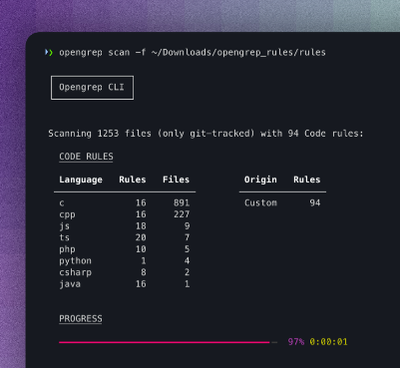
Security News
Opengrep Emerges as Open Source Alternative Amid Semgrep Licensing Controversy
Opengrep forks Semgrep to preserve open source SAST in response to controversial licensing changes.
github.com/containers/storage
storage is a Go library which aims to provide methods for storing filesystem
layers, container images, and containers. A containers-storage CLI wrapper
is also included for manual and scripting use.
To build the CLI wrapper, use 'make binary'.
Operations which use VMs expect to launch them using 'vagrant', defaulting to using its 'libvirt' provider. The boxes used are also available for the 'virtualbox' provider, and can be selected by setting $VAGRANT_PROVIDER to 'virtualbox' before kicking off the build.
The library manages three types of items: layers, images, and containers.
A layer is a copy-on-write filesystem which is notionally stored as a set of changes relative to its parent layer, if it has one. A given layer can only have one parent, but any layer can be the parent of multiple layers. Layers which are parents of other layers should be treated as read-only.
An image is a reference to a particular layer (its top layer), along with other information which the library can manage for the convenience of its caller. This information typically includes configuration templates for running a binary contained within the image's layers, and may include cryptographic signatures. Multiple images can reference the same layer, as the differences between two images may not be in their layer contents.
A container is a read-write layer which is a child of an image's top layer, along with information which the library can manage for the convenience of its caller. This information typically includes configuration information for running the specific container. Multiple containers can be derived from a single image.
Layers, images, and containers are represented primarily by 32 character hexadecimal IDs, but items of each kind can also have one or more arbitrary names attached to them, which the library will automatically resolve to IDs when they are passed in to API calls which expect IDs.
The library can store what it calls metadata for each of these types of items. This is expected to be a small piece of data, since it is cached in memory and stored along with the library's own bookkeeping information.
Additionally, the library can store one or more of what it calls big data for images and containers. This is a named chunk of larger data, which is only in memory when it is being read from or being written to its own disk file.
Contributing Information about contributing to this project.
FAQs
Unknown package
Did you know?

Socket for GitHub automatically highlights issues in each pull request and monitors the health of all your open source dependencies. Discover the contents of your packages and block harmful activity before you install or update your dependencies.

Security News
Opengrep forks Semgrep to preserve open source SAST in response to controversial licensing changes.

Security News
Critics call the Node.js EOL CVE a misuse of the system, sparking debate over CVE standards and the growing noise in vulnerability databases.

Security News
cURL and Go security teams are publicly rejecting CVSS as flawed for assessing vulnerabilities and are calling for more accurate, context-aware approaches.